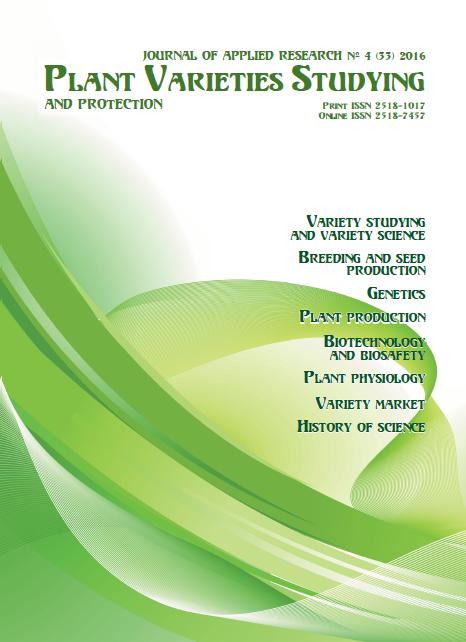New spring wheat varieties ‘Panianka’ and ‘Diana’
DOI:
https://doi.org/10.21498/2518-1017.4(33).2016.88690Keywords:
spring wheat, variety, productivityAbstract
Purpose. To create new competitive spring wheat varieties.
Methods. Field study, laboratory test.
Results. Based on the competitive variety trial, bread spring wheat line ‘Lutescens 07-26’ has been selected due to high values of such traits as resistance to fungal diseases, grain quality(protein content accounted for 15.0%), 1000 kernel weight (44.6 g) productivity (3.92 t/ha) and lodging resistance (9 points). In 2011, it was submitted to the State variety testing as ‘Panianka’ variety. Durum spring wheat line ‘Leukurum 08-11’ was characterized by a number of positive traits: quite a high productivity (3.05 t/ha), short stem (79 cm), resistance to fungal diseases and lodging(9 points), and in 2011 it was submitted to the State variety testing as ‘Diana’ variety. According to the results of the State variety testing in 2012–2014, spring wheat varieties ‘Panianka’ and ‘Diana’ in 2015 were put on the State Register of plant varieties suitable for dissemination in Ukraine.
Conclusions. For farms in Forest-Steppe and Polissia zones of Ukraine, bread and durum spring wheat varieties were bred by V. M.Remeslo Myronivka Institute of Wheat of NAAS of Ukraine that demonstrated rather high potential of productivity and adaptability to stress conditions. This goes to prove that cultivation of domestic spring wheat varieties will promote formation of high and quality grain yields.
Downloads
References
Kalenska, S. M., Dmytryshak, M. Ya., Demydas, H. I., Mokriienko, V. A., Yunyk, R. V., & Kovalenko, R. V. (2014). Roslynnytstvo z osnovamy kormovyrobnytstva [Plant growing with the basics of forage production]. Vinnytsia: Nilan. [in Ukrainian]
Kuperman, F. M., Murashev, V. V., Shcherbina, I. P., Ananyeva, L. V., Yaroshevskaya, A. S., & Bykova, M. S. (1980). Metodicheskie rekomendatsii po opredeleniyu potentsialnoy i realnoy produktivnosti pshenitsy [Guidelines for evaluation of the potential and real productivity of wheat]. Moscow: VASKhNIL. [in Russian]
Medvedovskyi, O. K., & Ivanenko, P. I. (1988). Enerhetychnyi analiz intensyvnykh tekhnolohii v silskohospodarskomu vyrobnytstvi [Energy analysis of intensive technologies in agriculture]. Kyiv: Urozhai. [in Ukrainian]
Lykhochvor, V. V., & Petrychenko, V. F. (2006). Roslynnytstvo. Suchasni intensyvni tekhnolohii vyroshchuvannia osnovnykh polovykh kultur [Plant growing. Modern intensive technologies of cultivation of staple crops]. Lviv: Ukrainski tekhnolohii. [in Ukrainian]
Lykhochvor, V. V., Petrychenko, V. F., & Ivashchuk, P. V. (2006). Zernovyrobnytstvo [Grain production]. Lviv: Ukrainski tekhnolohii. [in Ukrainian]
Zhemela, G. M. (2003). Yakist zerna ozymoi pshenytsi [Quality of winter wheat grain]. Kyiv: Urozhai. [in Ukrainian]
Derzhavnyi reiestr sortiv roslyn, prydatnykh dlia poshyrennia v Ukraini v 2016 rotsi [State Register of plant varieties suitable for dissemination in Ukraine in 2016]. (2016). Retrieved from http://vet.gov.ua/sites/default/files/reestr%2014.04.2016.pdf [in Ukrainian]
Nikolaev, E. V. (1991). Rezervy uvelicheniya proizvodstva zerna silnoy i tsennoy pshenitsy [Reserves to increase the production of strong and valuable wheat grain]. Kiev: Urozhai. [in Russian]
Volkodav, V. V. (Ed.). (2000). Metodyka derzhavnoho sortovyprobuvannia silskohospodarskykh kultur. Vypusk 1. Zahalna chastyna [Methods of State variety testing of agricultural crops. Issue 1. General part]. Kyiv: N.p. [in Ukrainian]
Babaiants, L., Mesterhazy, A., Wachter, V., Neklesa, N., Dubinina, L., Omelchenko, L., … & Bartosh, P. (1988). Metody selektsii i otsenki ustoychivosti pshenitsy i yachmenya k boleznyam v stranakh-chlenakh SEV [Methods of Breeding and Evalua
Downloads
Published
How to Cite
Issue
Section
License
Copyright (c) 2016 Ukrainian Institute for Plant Variety Examination

This work is licensed under a Creative Commons Attribution-ShareAlike 4.0 International License.
Starting in 2022, the copyright to the publication remains with the authors
Our journal abides by the CREATIVE COMMONS copyright rights and permissions for open access journals.
Authors, who are published in this journal, agree to the following conditions:
- The authors reserve the right to authorship of the work and pass the first publication right of this work to the journal under the terms of a Creative Commons Attribution License, which allows others to freely distribute the published research with the obligatory reference to the authors of the original work and the first publication of the work in this journal.
- The authors have the right to conclude separate supplement agreements that relate to non-exclusive work distribution in the form in which it has been published by the journal (for example, to upload the work to the online storage of the journal or publish it as part of a monograph), provided that the reference to the first publication of the work in this journal is included.

























 Ukrainian Institute for Plant Varieties Examination
Ukrainian Institute for Plant Varieties Examination  Селекційно-генетичний інститут
Селекційно-генетичний інститут Institute of Plant Physiology and Genetics of the National Academy of Sciences of Ukraine
Institute of Plant Physiology and Genetics of the National Academy of Sciences of Ukraine
 The National Academy of Agrarian Sciences of Ukraine
The National Academy of Agrarian Sciences of Ukraine